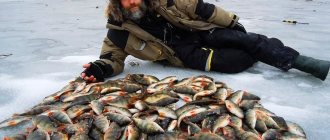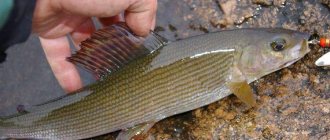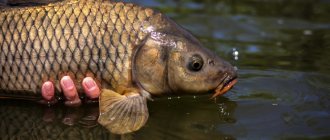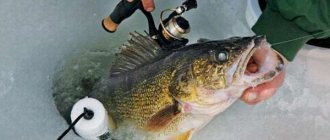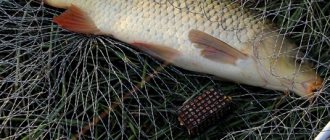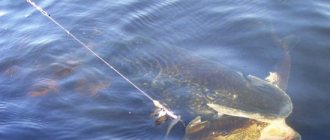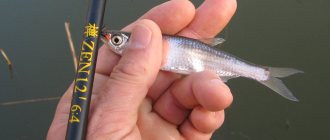Bersh is a beautiful and tasty fish of the perciform order, very similar to pike perch, but different from it in appearance and size. The size of the bersh rarely exceeds 1 kg, averaging 150–500 grams. The main difference by which bersha is distinguished from pike perch is the absence of fangs on the jaws and a brighter striped color.
In Moscow, Penza, and some other regions, bersh are scarce and are prohibited from catching (see “Fishing Rules”).
Bersh are most numerous in reservoirs on the Volga River, and in the river itself, starting from the Ivankovo Reservoir. Its abundance varies, increasing as the Volga moves towards the Rybinsk, Gorky and Cheboksary reservoirs, reaching a maximum concentration in the Kuibyshev reservoir. There is a lot of it downstream, in the Samara, Saratov, Volgograd, and ending with the Astrakhan regions.
The best time to catch a predator is in winter
Winter fishing for bersha begins from the moment of freeze-up, in early December. Hundreds of bersh fishermen flock to the ice as soon as it reaches the required strength of 10 centimeters. Active biting continues throughout the month, then the bersh becomes capricious. At the end of winter, in March, the bite intensifies again and continues until the end of the freeze-up.
When there is first ice, bersh begin to peck early in the morning, often in the dark. If at the beginning and end of winter, it is caught all day, with varying success, then by mid-winter the bite becomes distinct in the morning and evening hours, waning by the middle of the day. I’ll tell you about the extremely exciting fishing for bersh in winter, using active and passive gear.
Features of fishing
Fishing for bersh with sprat in winter, unlike fishing with balance beams, vertical spoons and other specialized baits, is relatively easy to learn, does not require serious financial costs, and at the same time is extremely productive.
The main advantages of fishing for sprat are:
- does not require a large set of diverse baits,
- variability of equipment,
- availability and cheapness of gear,
- simplicity of fishing technique,
- opportunity to catch passive fish.
The equipment begins to show results from the very first day of winter. With the onset of wilderness, its effectiveness does not decrease. On the contrary, the sprat works when the bersh and pike perch completely refuse to take classic baits, spoons, wasps, balance beams, helicopters and others.
At shallow depths a jig is used, at greater depths a jig head is used.
Another important feature of sprat is that this bait can be used in different types of winter gear. In addition to the common jig head with an open, hard-soldered single hook, they are caught using stationary baits, using combinations of vertical spinners and heavy jigs, attaching fish to rigs and other devices.
On the first ice
For all fishermen, first ice is associated with a good bite, ease of fishing, and the opportunity to return home with an impressive catch. That’s why most “penguins” prefer to catch pike perch with sprat in winter using a balance beam and a spinner. This does not require bait, and there is no need to constantly refresh it.
However, not all fishermen use this approach. Those who do not have a sufficient arsenal of baits, for various reasons, still fish with sprat. To do this, it is enough to have a set of jig heads of different weights and sizes, and in terms of productivity the method is not inferior to classic lures.
In February
Fishing for sprat shows its best qualities with the onset of February, when the majority of the reservoirs are in deep winter, and the fish enters suspended animation due to poor oxygen conditions and depression, which developed after a long winter period.
Advice! February is characterized by the absence of reliable bites and the need to constantly move around the reservoir, looking for the location of the feeding predator.
At this time, pike perch and bersh react increasingly worse to the offered spoons and balancers, ignoring them or occasionally butting them, without swallowing them. The sprat comes to the rescue, with its natural appearance and smell, capable of inducing a predator to a confident grip.
Assembling active gear
Winter active gear for bersha consists of a rod, reel, and actually bait. A rigid fishing rod is chosen, as it ensures effective hooking of fish, often from great depths. At the same time, it should be light and not tire the angler with excess weight. During active fishing, the fishing rod is constantly in the hand, and fishing is sometimes carried out from morning to evening. Fishing rods made of carbon fiber and composite materials of short length are suitable.
The reel must have a rigid spool fixation for clear hooking of fish. A friction brake is not necessary for catching bersh. Use inexpensive polycarbonate models equipped with a trigger for quick line release. If you want to get serious about winter bersh fishing, consider more expensive specimens, such as the flagship among winter reels - the Russian-developed Nelma-Z , which has a durable and reliable design. I have three modifications of this reel, and all three did not let me down on the pond, even in the most severe frosts.
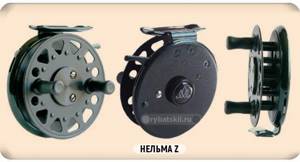
Coil Nelma-Z
The diameter of the reel spool should allow you to wind at least 50 meters of fishing line with a diameter of up to 0.3 mm on it.
The fishing line is used with a diameter of 0.2 to 0.3 mm; thin winter fishing line is often used in strong currents so that the bait is less carried away. Thick fishing line is used in places with a gentle current, and where there is a high probability of catching a large bersh, or when catching pike perch using sprat (which often hunts with bersh).
If you have a serious interest in winter fishing for bersha, opt for fluorocarbon fishing lines. In addition to the low visibility of the fishing line for fish, an important factor when fishing for bersh is the low elongation of fluorocarbon. At great depths, often 20 meters or more, hooking fish will be more effective compared to monofilament fishing line. In addition, this line tangles less in the wind, which is also important at such fishing depths.
Tackle
How to prepare tackle for catching pike perch in winter
The gear for catching pike perch and bersh on sprat is quite simple and undemanding in terms of the elements it consists of. Anyone can easily assemble a kit without any significant financial costs:
- A rigid fishing rod with a length of 60 to 120 cm with the strength necessary for landing large fish;
- An open reel with sufficient line capacity, a simple friction mechanism, without iron elements in the design;
- Monofilament fishing line, with a diameter of 0.20 to 0.35 mm with a breaking load of 3–7 kg, is selected depending on the size of the potential prey.
It is not necessary to use a nod. If the tackle is assembled correctly, then all bites are clearly transmitted to the hand, even the most timid contacts are heard as an insignificant “bale” that requires an immediate sharp hook.
It is advisable to equip the lightest possible tackle, since during the fishing process your hand will certainly get tired from constant swings of the rod. In addition, light weight guarantees better sensitivity and allows you to easily vary animation techniques, experimenting and selecting the optimal wiring in a particular situation.
Selecting and making a nod
The nod for catching bersh in winter is set to moderately hard, and it bends under the weight of a 5-10 gram bait by 30–45 degrees.

Often, fishermen use guards made of a silicone tube and a paper clip, bent into the shape of a ring, and inserted into the tube. This original design is simple and reliable in the cold, and also transmits even barely noticeable touches by the fish to the bait. This design does not interfere with frequent reeling and releasing of the fishing line, which often has to be done in deep-sea fishing.
The tackle ends with a carbine and a swivel, small in size, but powerful enough to weigh up to 8–10 kg (we remember that large pike perch often hunt nearby, and we don’t want to lose expensive baits and chances of catching a trophy).
Jig for bersh and pike perch
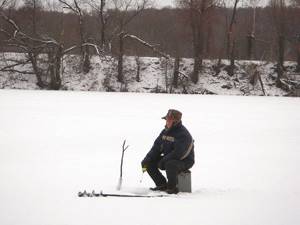
Photo by the author
It seems that spring fishing from ice on large rivers and large navigable reservoirs is the best time to successfully catch such related schooling predators as pike perch and bersh using specific baits, which, it should be noted, are also unlikely to be used to productively catch perch, the same close relative of these predators. And the point here is that on the eve of spawning, large caviar perches clearly give preference to sluggishly playing or generally motionless small baits with bait, and bersh and pike perch, showing stronger predatory inclinations, especially in a school, do not disdain large baits, although they casually grab and a single bloodworm on a small hook, and a tiny jig on the thinnest fishing line.
It is spring fishing for predators that refutes the established stereotype that in this case the most productive baits are either the usual vertical spoons with different characteristics of behavior when playing in the water, or balancers of various weights and colors. On the eve of the ice breaking up on large reservoirs and rivers, pike perch and bersh filled with caviar and milk become so heavy that it seems as if the imminent release of reservoirs does not “make them happy” at all, and, as many years of fishing practice shows, they use large baits like spinners or balancers often they only vaguely “knock”, but they very rarely sit securely on the hooks, and there are also many annoying accidents. And this despite the fact that concentrations of the predator have to be found with considerable difficulty, making many holes in the ice cover that is extremely thick by spring.
In such a situation, many fishermen in recent years have developed a special technique for catching large pike-perch and bersh using jigs of the size and weight corresponding to the fishing conditions, the type of predator, and the bait used. At the same time, it is necessary to once again emphasize that a special jig is most effective in the case of these schooling predators and gives almost no results when catching individualistic pike, but at the same time it can well be adapted for high-speed fishing of ide or chub, as well as at night burbot fishing. And the success of catching pike perch and bersh sometimes with a very large jig is due to the fact that these predators, unlike large perch, which is extremely picky in the spring, stay in small aggressive schools during all periods of winter and during feeding pay little attention to the quality of the tackle, therefore, having caught where - one predator, you should most likely expect several more bites in the holes made nearby. This is exactly what the tactical scheme for pike perch or bersh fishing is based on, both with a spoon and a jig - the main thing is that as a result of persistent searches with drilling a large number of holes, catch the first predator, then a systematic “drilling out” of the fish is carried out close to the bite site.
Now is the time to talk about the actual bite of bersh or pike perch using a jig. And there is nothing special about it - as a rule, it is clear and sharp, and the fish takes the bait quite deeply, which determines a reliable hook. And the predator takes it almost on the very first retrieve with a fairly aggressive play with the jig, if it literally fell under his nose, but a fish standing even half a meter away may not react to the bait in any way. So you have to “drill out” the prey, as they say, making many holes at small intervals and eventually completely “covering” the found flock.
Naturally, luck awaits the fisherman in those reservoirs where, during the most difficult spring period on the eve of the flood, a favorable oxygen regime is maintained and where pike perch and bersh are found in sufficient quantities. For example, even the well-known “drinking” reservoirs near Moscow, by and large, do not satisfy these conditions due to their weak flow and the general low activity of all underwater inhabitants - both prey and, as a consequence, hunters for them. But it is quite effective to catch these predators in all reservoirs of the Volga cascade, on large and fast rivers like the Oka, Don, Dnieper, as well as in their extensive backwater quarries with deep access to the river, into which predators, as well as their potential food, especially tend to en masse on the eve of stormy spring events in the river associated with floods.
If fishing is carried out in a body of water without a current, such as a backwater, then the size of the pike-perch jig can be quite modest - here everything is determined not by some predilections of the predator, but by considerations of necessity and sufficiency. The fact is that pike perch and bersh are deep-sea fish in winter conditions, so they often have to be caught in places where the depth can exceed the ten-meter mark. This means that in this case, the jig with its weight should well pull out the entire fishing line lowered under the water, which with a diameter of less than 0.17-0.20 mm makes almost no sense in using it, since these predators have a very hard mouth, and even with a thin fishing line it will not penetrate an excellent hook, because with a long length, a thin fishing line on the hook will “work” like an ordinary elastic band, extinguishing the force applied by the angler.
It is clear that a thick fishing line has a fair amount of buoyancy - to compensate for this, as well as its rigidity, the weight of the jig for the specified fishing conditions should be in the range of 1.5-3 grams. By the way, in addition to its necessary rigidity, a thick fishing line has another significant advantage: it gets tangled less on ice in windy weather after landing another trophy, although this trouble can be avoided by using a small but high-speed spinning reel on a fishing rod. When fishing for pike perch and bersh at a significant current along river-bed dumps, a jig is already used, the weight of which is at least sufficient so that during retrievals it does not “lose” the bottom, although it will move somewhat downstream from retrieving to retrieving, for which you will need a fishing line give in little by little. However, this is better than an excessively heavy bait - with a jig “walking” along the bottom, you can achieve a greater number of bites. And, nevertheless, large jigs for current are more reminiscent of jig heads with a weight of up to 10 grams or even more.
It is more effective to catch pike perch and bersh using large jigs with one bait or another - but with which one, it greatly depends on the type of reservoir, the local preferences of the predator and its size. As a rule, in quiet river areas, at great depths of backwaters, predators, especially small ones, are excellent at taking bloodworms, when up to a dozen larvae are attached to a fairly large but thin hook of the bait at once. You can use a worm, but for some reason the bite on it is noticeably worse. In recent years, in all the Volga reservoirs, where sprat have proliferated incredibly, only this fish, prepared for future use, seems to have become the only and indispensable bait when catching pike perch and bersh here. The sprat is usually used dead, placed on a fairly thick and large hook, piercing it right through the fish’s head - this way it holds more securely, sometimes withstanding several bites. Sometimes sprat is no less successfully replaced with verkhovka, which in some ponds can be quickly caught with a small jig right under the ice, and then frozen in the refrigerator for future fishing trips.
Anatoly Mailkov March 25, 2013 at 00:00
How to cut and plant sprat
In the vast majority of cases, for successful fishing, all catchable baits for ice fishing for bersh require replanting pieces of sprat. Sprat is the main food item for bersh. Sprat is purchased in fishing stores in advance, fresh or frozen. Fresh sprat is the most attractive for fish . It holds the hook well, attracting fish with its smell. Before fishing, you should use scissors to divide the sprat into 2-3 parts, depending on the size, and place the sprat pieces in a foam container.
Place a piece of sprat on each hook of a spinner or jig. During the period of active biting, you can, in order to save money, put the sprat on 2 or one hook.
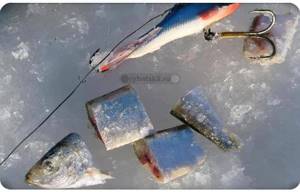
In some reservoirs, both worms and bleak are used, but these baits are more suitable for stationary fishing with bait, which I will discuss below. Despite this “unsporting” gear, the choice of the type and weight of bait that will bring the sprat to the bottom is also important, and sometimes decisive. We'll talk about this below.
Selection of working baits for different fishing depths
As already noted, fishing in winter takes place at depths from 5 to 25 meters, so the fisherman’s box with bait turns out to be heavy. Each of the baits is presented in several weights. This is necessary for comfortable and effective fishing at any depth and on any current, which sometimes changes several times a day.
Spoons for bersha in winter
The Admiral spinner is a unique invention of Volga fishermen, an inconspicuous and inexpensive bait, but perfect for fishing in strong currents and great depths. Available in several colors and weights from 10 to 28 grams. You need to have several baits, from minimum to maximum weight of different colors.
Replace the tee on the bait with a branded one, for example, Owner, of a similar or slightly larger size.
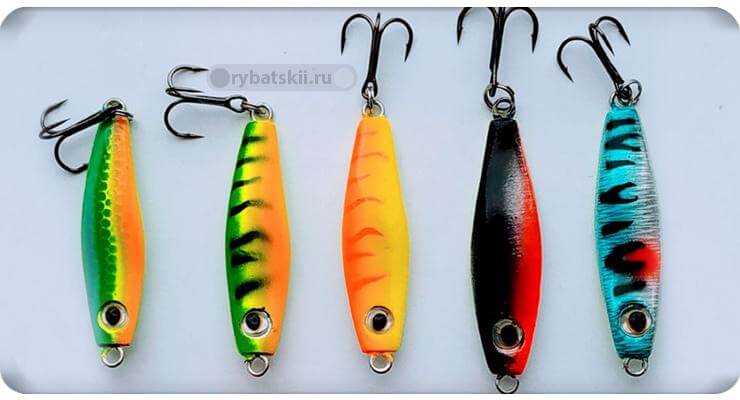
Spinner Admiral
Spinner Swedish Pimple ("Swedish Pimple"), 50 mm (9 grams) - a successful spinner for catching bersh in winter, at shallow depths of up to 10-12 meters, with a current of medium strength. For deep places with strong currents, heavy varieties of this spoon are used. Cheap Chinese analogues of this bait also work (you just need to change the hooks).
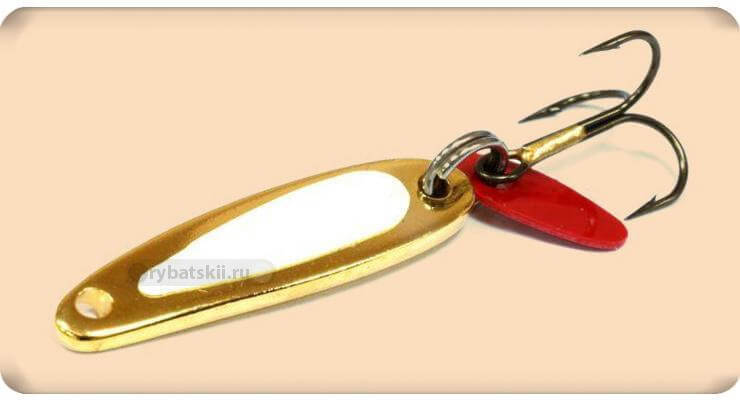
Swedish pimple
Rosy Dawn Classic spinner, 57 mm, 7 grams - color does not play a decisive role. The spoon is designed for catching bersh at a depth of 7–9 meters and in weak currents.

Rosy Dawn Classic
Little Cleo spinner, 47 mm, 9 grams – silver, “acid” color, as well as a light-accumulating color. This is an excellent spoon, it works on the first ice, collecting fish from a large area. The spoon will also be appropriate for shallow depths and weak and medium currents.
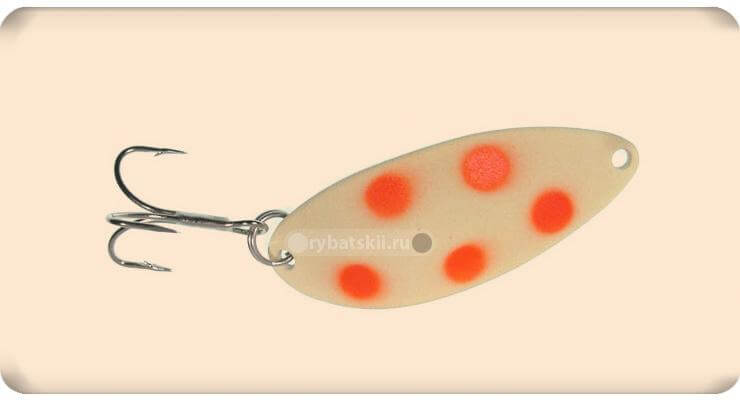
Little Cleo
Mormyshki on bersha in winter
Mormyshka ball, weight 5–15 grams. The jig is used for weak and moderate currents, depending on the weight. Works during periods of weak bite, allowing you to catch the most cautious fish. Since fishing is carried out at great depths, jigs with a light-accumulating coating (luminophor) work well. If it is not possible to purchase a special jig, use an ordinary summer jig head with a soldered-in small but sharp hook.
Jig “Pike-perch cone”, weight 15–28 grams. This jig also works along the bersh in winter, at great depths and strong currents. Luminescent colors are also popular. Also add jigs weighing 7–28 grams to your arsenal of baits.
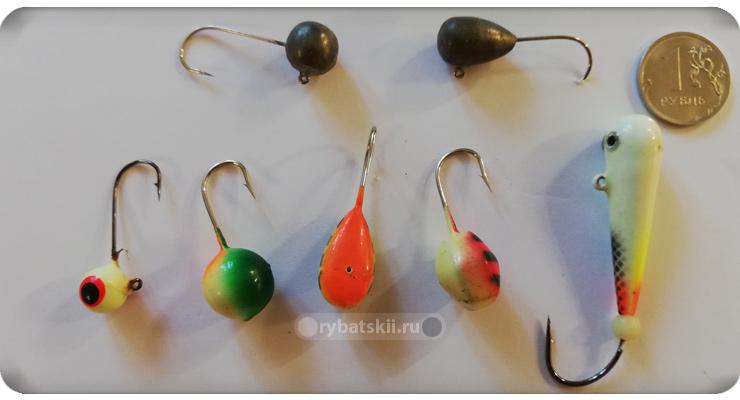
Among the baits, I deliberately do not use various types of balancers equipped with several hooks. They catch fish in almost the same way in winter, but in the current they often hook their hooks onto the edges of the holes. If, nevertheless, the fish managed to get on the ice, such baits begin to cling to the gloves and clothes of the fisherman, trying to ruin expensive equipment.
Regular, active fishing is possible using the baits described above, purchased in different weights. Of course, every fisherman also has unique handmade lures, which accumulate in boxes as he gains experience.
Lures
Like any other predator, catching bersh in winter uses artificial baits - jigs and spinners. Depending on the activity of the fish and fishing conditions, any of them can be quite catchy, but jigs are used more often.
Characteristics of jigs
A jig is an artificial metal bait that consists of a hook and a body of various shapes. Based on the size and preferences of the fish, baits are selected according to the following characteristics:
• large size, large hook, No. 3-4 according to the international size chart; • in terms of weight, it is better to take heavy tungsten baits - they often catch bersha in strong currents and great depths, so the bait must not only quickly sink to the bottom, but also resist the flow of water; • color silver, white. It is better to purchase models with a fluorescent coating; • among the models, the most catchy ones are “droplets” and “uralkas”.
Fishermen often advise taking jigs made of copper and stainless steel, painted white - such baits are quite noticeable at great depths and better attract predators.
They don’t catch bersh with a bare hook; they usually use a bunch of bloodworms as a bait. It is also easy to decorate the hook with multi-colored threads or wool.
Game tactics
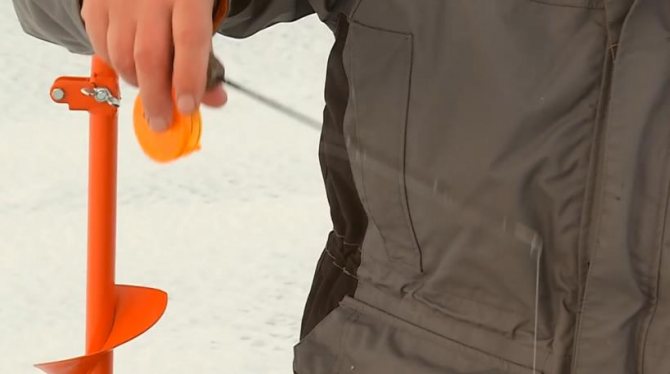
Bersh stays in the bottom layers, so catching it at higher horizons is pointless. Playing with a jig is not too complicated and consists of lowering the bait until it touches the bottom, followed by a slight rise and descent with a pause.
When fishing in currents, the stepwise fishing tactics work well:
• the bait is lowered into the hole until it touches the bottom; • then remove about a meter of line from the reel and raise the fishing rod at arm's length; • the rod is lowered smoothly so that the bait in free fall falls downstream and hits the ground; • after a short pause the action is repeated.
Thus, the bait can be carried from the hole to a distance of 15-20 meters. An important point is the tapping of the jig on the ground, which reminds the predator of the fry swarming and provokes a lunge.
The wiring can be of a different type - without melting the bait too far from the hole:
• the bait touches the bottom; • the jig is raised and, having released 2-3 meters of fishing line, is released into a free fall with the flow; • the bait is smoothly pulled up until it finds itself exactly under the hole - this is evidenced by the vertical position of the fishing line; • pause for about 5 seconds and slowly rise 20 cm upward with slight fluctuations; • at the top point there is a pause of 8-10 seconds; • the bait is released and, after touching the bottom, several taps are made on the ground, raising a cloudy cloud; • the rise is repeated; • after several cycles of raising and lowering the bait, the whole game is repeated from the beginning.
The length of pauses, distance and speed of the drive may vary and depend on the activity of the predator. During the fishing process, it is worth experimenting, selecting the most successful combinations of the game.
Characteristics of spinners
Catching bersh in winter with a spoon is no less exciting than with a jig, and has many fans among active fishing enthusiasts. Lures must meet the following requirements: • small size, usually 4-6 cm in length; • weight is rarely more than 10-12 grams, but can vary depending on the strength of the current; • light color – white, silver, lemon, orange; • single hook; • models – jigs, castmasters, as well as small jigs. Narrow-bodied studs work well; • the spoon can be made more catchable by covering it with a light-accumulating substance. When trolling bersh, you should use bait made from a large worm or small pieces of fish, which will significantly increase the number of bites.
Game tactics
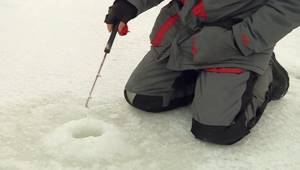
When catching bersh with a spoon from ice, a vertical retrieve technique is used, so the shape and action of the bait must be appropriate. The angler selects game options directly while fishing, but several general ones can be identified:
Option 1: • the spoon is lowered into the water and stops 10-20 cm from the bottom; • a sharp swing 1 meter up; • slowly lower down for 10-15 seconds.
Option 2: • the bait sinks to the bottom; • rise up by 30-40 cm; • sharp release until the hook touches the ground; • a pause of 5 to 15 seconds, or more - it all depends on the activity of the fish.
Option 3, used on rivers with strong currents when fishing with bait: • after the bait touches the bottom, it rises to a small height; • the spoon is released into free fall, releasing the fishing line so that it is carried downstream; • after a pause, the spoon is slowly pulled up, dragging along the bottom.
How to find a predator
Deep areas of the reservoir are suitable for catching bersh, usually in riverbed ditches and irrigation areas. A good place for fishing is in irrigation areas adjacent to a deep riverbed with a depth of 10–15 meters. Bersha is often found in the deepest parts of the riverbed, at a depth of up to 25 meters, with a strong current.
Bersha sites in reservoirs are flooded old river beds. It’s good to mark such places in your navigator in advance. By the way, there will be an old map of the area before the flooding. Linked to a GPS navigator based on coastal landmarks, such a map will provide a huge number of potentially catchable places with bersh. These are ravines, former mouths of small rivers and streams, holes and ditches.
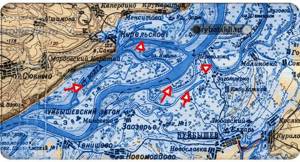
Fishing tactics if you don't bite
As a rule, in the morning the bersh begins to peck from a depth of 7–9 meters, gradually sliding into deeper places. Therefore, start your search for a predator in the shallows. Usually, at this depth, the bersh begins to bite immediately, within 1–5 minutes. If there are no bites, change the fishing location.
During the day, if there are no bites, it is necessary to move to greater depths.
If you couldn’t find the bersh, then look for it on the edges and in the riverbed itself, at considerable depths. Often this tactic is successful.
Moving through a reservoir, bersh pursues schools of forage fish - often sprat, sometimes river invertebrates - crustaceans and shrimp, so at the beginning of fishing, determine the direction of the current by the angle of drift of the fishing line. It is convenient to mark a coastal landmark for yourself. The fish move in this direction, and moving with or against the current from a catching hole, you can often follow a school of fish. This way, new happy places are found, and precious time is not wasted fishing neighboring, often fishless areas.

Inexperienced fishermen may not understand why they stop biting. At this time, an experienced fisherman, having drilled a hole in the ice nearby, seemingly without any apparent logic, suddenly begins to catch fish. Considering these recommendations, as well as observing your more successful neighbors, turn chaotic ice drilling into a conscious search for fish. Of course, using only one search tactic, you won’t catch fish. Therefore, let’s move on to the technique of catching bersh using active baits.
Fishing with sprat in winter bersha
Bersh is in many ways similar to pike perch, not only in appearance, but also in behavior. Therefore, they practically never catch bersha on purpose - not only do the habitats often overlap with pike perch, but the baits are also similar in many ways.
The main difference between bersh and pike perch is size - the maximum weight of bersh is 1.5-2 kg, but more often individuals weighing 500-800 grams are caught.
The principle of catching pike perch can be taken as a basis for catching bersh with sprat, only with some differences.
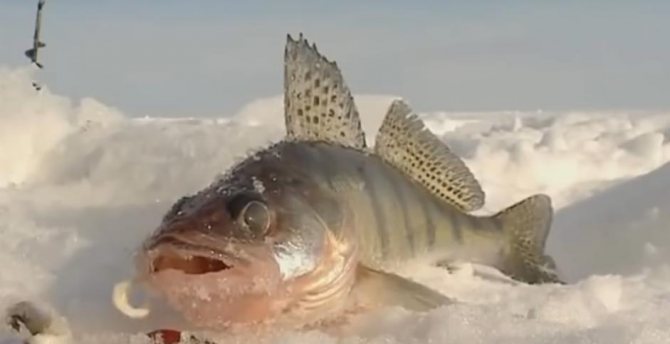
Tackle
You can take the same gear as for catching pike perch. This will help avoid cliffs if, instead of a bersh, its larger brother bites.
If you purposefully go after a bersh, then a thinner rig with a less powerful fishing rod will do. Line diameter – 0.2 mm.
Lures
You can use medium and large jigs, oval or round in shape. Considering that bersha are caught mainly in medium and strong currents, it is better if they are made of tungsten, which has a higher specific gravity than tin or lead.
Spoons and balancers are selected small, based on the size of the bersh. Lures up to 7 cm long are optimal, with an average length of 3-5 cm. Hook size is 8-10.
Fishing tactics
The tactics for catching bersh in winter using sprat can be used the same as when catching pike perch. One of the differences is the fish's approach to the bait. Unlike pike perch, bersh takes the bait very carefully, as if testing it. He can bite off a piece of sprat without touching the hook, and too hasty hooking will leave the angler without prey. When moving the nod, you need to wait a little, giving the predator the opportunity to thoroughly swallow the hook. Depending on the size of the bersh, the sprat can be planted either as a whole or in small pieces of 2-3 cm, especially when using small spoons.
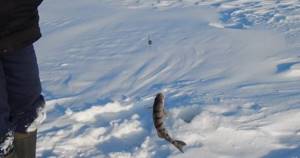
When playing with bait, in addition to the usual ascents and descents, they often use pulling, letting the tackle float freely with the current and slowly pulling it back.
Selecting a location
To minimize pike perch bites when fishing for bersh, you should carefully select your fishing spots. Unlike pike perch, bersh prefers rivers and channels with strong currents. It is especially good if there are a large number of snags and stones at the bottom. The soil prefers sandy and rocky. In the dead of winter it goes into deep snags. In sunny weather it often rises onto sandbanks with snags.
Features of catching bersh on the first ice
Fishing for bersh is very interesting, primarily due to the varied and unexpected bites of this fish. Selecting the right bait, determining what kind of animation the fish prefers today - this is what attracts lovers of catching this fish.
Often on the first ice, fishing for bersha is prey and exciting. If there are a lot of fish in the found place, then fishing comes down to simply lowering the bait into the hole, shaking it near the bottom, at a depth of 5–20 centimeters. Bersh sometimes greedily, grabs the bait and bends the nod. The angler’s ability to work with gear comes to the fore - laying a long line downwind, avoiding snags on ice and clothing.
It will be important to be able to quickly remove the fish from the hook, adjust the attached sprat and send the tackle back to the hole. To do this, the fisherman must be prepared - waterproof gloves, pliers for removing the hook.
In this case, you should attract as little attention as possible from other, less fortunate fishermen. When approaching a crowd of anglers actively fishing, try to approach them from the leeward side, from behind. At the same time, you control the actions of all fishermen, and no one will see you.
Let us dwell in more detail on a more frequent and difficult case - “labor” fishing for inactive bersh, at great depths and strong currents. Many fishermen are not ready for this.
Fishing technique
First, the fishing line is lowered downstream , making stepwise wiring. Thus, the fishing zone increases, which is what is needed when fishing for bersh. This fish usually bites far from the hole. Optimal gear should allow for a distance of 20 to 30 m.
Wiring must be done slowly and smoothly , with a large amplitude of vibrations. After a meter of line, you need to twitch the tackle, gradually lowering the rod. The result should be tapping along the bottom, similar to stepped wiring. After this, the fishing rod rises to the distance of an outstretched arm and smoothly lowers, so that the jig moves along the bottom.
A meter of fishing line is unwound again and the steps are repeated. The bersh bites almost imperceptibly, so it makes sense to make hooks from time to time.
You need to start catching bersh at dawn. By 7 o'clock the activity of this fish reaches its limit. Later, catchability gradually decreases, as schools begin to actively move around the pit and it is very difficult to track them. In the afternoon you can have a quiet snack and do other things.
Before dusk, the bersh becomes active again, but stops pecking with the onset of darkness. Drill holes over edges and slopes every 6 meters. You need to immediately be ready for active running. Usually in 10 holes only one brings tails.
The nuances and difficulties of fishing in the current
In deep places with a current, fishing begins with the selection of bait, which, when lowered to the bottom, sticks to it a little. Once lowered to the bottom, the bait should not be immediately carried away by the current. After this, lift the spoon or jig from the bottom, and with smooth movements, with minimal amplitude, lift the bait from one to 15–40 centimeters. When lowering to the bottom, if the bait is chosen correctly, it should be carried away a little by the current, for which we release the fishing line from the reel by 20–30 centimeters. The next time it touches the bottom, we again begin lifting the bait with a minimum amplitude, and play with it until the bait is carried away by the current again.

Thus, the bait moves several meters away from the hole. This will allow you to control the bottom where the bersh is held. And also to fish a large area, and not just the area that is located directly under the hole. With a depth of 15–20 meters and a strong current, such a release can be significant - up to 20 meters, and the distance from the pecked fish to the fisherman is up to 40 meters. When releasing the bait in this way, you should carefully watch the guard so as not to miss a barely noticeable bite, and when biting, immediately hook with a sharp and strong movement.
If the bait is instantly carried away by the current, and releasing the fishing line does not allow you to “feel” the bottom again, place a heavier and more compact bait. If the current does not carry the bait, the best fishing results can be achieved with a spinner or jig weighing up to 10 grams.
If the bersh is actively biting on the first ice, then it is enough to look for fish in the chosen place, drilling new holes. Closer to the middle of winter, the bersh often does not immediately appear at the hole, and in promising places you should “play” with the bait for at least 5–10 minutes before the bersh gathers from the surrounding area at the spinner, forming food competition, and the first fish dares to bite.
If a bersh does not react with a bite to active fishing with a spinner and a jig, but periodically betrays itself with timid touches of the bait, sometimes knocking down the sprat, try catching it with passive tackle - a stand.
Tackle for catching bersh in winter
You need a fishing rod with a large inertial reel. Diameter of at least 100 mm. This is explained by the need for frequent movements when actively searching for fish. When deep-sea fishing, reeling in the fishing line is especially problematic. Rewinding on a small fishing line takes a long time. And this needs to be done as quickly as possible, since it is much more difficult to reel in icy fishing line.
Some anglers act radically and completely abandon the reel. Moving from hole to hole, they wrap the fishing line around their elbow.
But not everyone likes this method, and it requires special skills. The fishing line clings to clothes and ice, and to deal with this you need to be quite dexterous.
Nod
A sensitive nod is an important part of the gear when fishing with bersha. This fish bites barely noticeably. A good nod option is a metal plate converging into a cone. This design is moderately elastic and sensitive.
fishing line
A diameter of 0.2 mm is enough. A thinner line will be inconvenient. Firstly, it hurts your hands, especially in cold weather. Secondly, it is confusing.
To make the tackle more sensitive , braided fishing line is often used. The inextensibility of this fishing line is an important advantage, but it also has significant disadvantages.
A thick fishing line is not needed, but a thin one will get tangled even worse than monofilament. In addition, a good braid costs a lot of money.
Equipment
It is better to take a drop-shaped jig made of white double metal. A good combination includes copper and stainless steel. If you wish, you can buy a fluorescent jig. It works great at great depths where darkness reigns.
Some fishermen are not limited to just one jig. The second is placed 20 cm above the first. It should be smaller in size. In order for the game of both baits to converge , it is better to attach the jig to the main fishing line - this way the sensitivity will be better, and, therefore, the hooking will be more accurate.
The small additional jig is tied first. The free end of the fishing line is threaded through the hole in the jig and the main line is tied at the required distance. The selection of bait must be done in such a way that the jig is gradually carried away by the current.
Alternative options can also be used.
Nozzle
They catch it with bloodworms . For bersh you need a whole bunch. Planting it in the cold is not a pleasant task, so it is better to prepare a bunch at home.
Are you interested in fishing with flags in winter? In this article we will talk about the main features of catching fish using this method.
This article will help you in choosing a winter tent for successful fishing.
Catching bersh on a stand

The fishing rod is almost no different from a regular fishing rod, but it is made in a simpler and cheaper design. Here the weight and price of the fishing rod are of less importance. There is no point in equipping such a fishing rod with an expensive reel. The reel will only be used for winding and reeling in line.
Change the shape of the nod. A nod-spring or a plate with a bright orange ball at the end would be appropriate. The ball sails a little and moves the rig in the wind, and thanks to it the bite is noticeable from afar.
Since the bersh often rises slightly from the bottom, tie an additional leash of the same fishing line, 15–20 centimeters long, above the bait. If you take the finished tackle vertically by the fishing line, the attached hook should be 3-5 centimeters above the bait and not cling to it. We use a single hook, size 2–4 according to the Owner classification.

Gear device
The fishing rod is equipped with a stand for installation on bare ice. If there is snow, a snowdrift formed by a fisherman can be a stand for a fishing rod. A jig is often used as a bottom bait.
You should be careful when planting the sprat. The best results were obtained when placing the entire small sprat on a single hook. This bait looks good in the current, and bites on it are more effective. Often the largest bersh and even pike perch are seduced and caught by the “whole” sprat.
The hole for placing is drilled next to the hole where they are caught with active bait. The distance between the holes is at least 3–4 meters to avoid overlapping of the lines under water.
Drill the hole with the bait in the direction of the wind - in front of you, so that when fishing with a spoon, you can see and control the nod of the bait. Periodically check whether the fishing line is frozen to the ice, clean the hole with a ladle. At the same time, the entire rig moves involuntarily, provoking the bersha, frozen in front of the choice “to bite or not,” a centimeter from the sprat. If a bite occurs, but you didn’t have time to run to the fishing rod in time, or the hooking turned out to be ineffective, don’t despair.
Bersch, despite its small size, is a greedy fish, and will definitely prove itself again. The design of the fishing rod allows you to play with the tackle a little, as is done when fishing with a spoon. Make a series of slow ascents to a height of 10–30 centimeters from the bottom, with a slow descent. If the fish does not bite, carefully lower the tackle to the bottom and place the fishing rod on the stand. Often a bite follows within a few seconds. If the fish does not bite again after a minute, pull it out and check the equipment - perhaps the fish managed to pull the sprat off the hook with impunity, or the leash with the hook got tangled.
Fishing for pike perch with sprat in winter
Pike perch is a large predatory fish, reaching 10-15 kg. Of course, in most reservoirs, individuals weighing 2-5 kg bite, but this in no way diminishes the interest of fishermen. Catching this large and strong fish is very interesting, and using sprat as bait increases the chances of a successful bite.
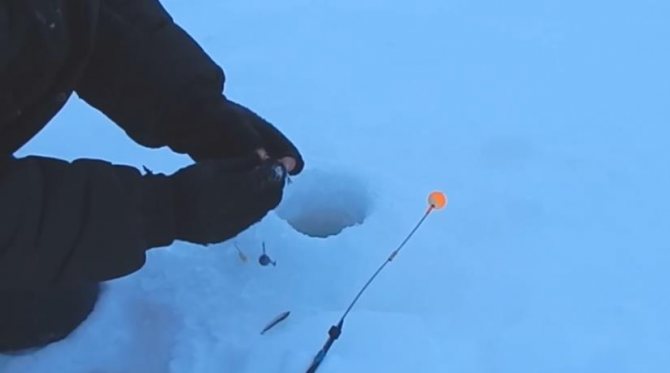
Tackle
All elements of equipment for winter fishing for pike perch must be of high quality and durable - the fish bites powerfully, and when fishing, it provides active resistance.
1. Rod. A strong and long winter fishing rod is used, always with a hard whip, so that you can break through the very strong jaws of the pike perch when hooking. Length from 40 cm.
2. Nod. In winter, especially in the dead of winter, pike perch bites become more accurate, so it is better to use nods with high sensitivity. Alarms made from flat metal springs or steel strips work well. They are superior in strength to other nods and behave better in extreme frosts.
3. Fishing line. It is better not to use braided line - it becomes too rough in the cold and does not have stretchability, which is important when fishing for pike perch. It is optimal to use a monofilament with a diameter of 0.25-0.30 mm, depending on the size of the fish in the pond. It is smaller than wicker, it gets tangled and does not cut your fingers as much if you grab it with your hands.
4. Coil. A simple round coil will suffice. You just need to take into account that it should be of medium or large diameter and accommodate at least 30 meters of fishing line - pike perch in winter is often found at great depths.
Equipment options
There are several options for equipping a winter fishing rod when fishing for pike perch using sprat: 1. Using a regular hook. This can be either a single hook, or a double or tee.
2. Fishing with a jig with a hook with a long shank, on which a whole fish is attached.
3. Conventional zander spoons for vertical retrieve and balancers, on which sprat is used as additional bait.
4. Ventilators and supplies. But this method has few supporters, since with such gear it is better to catch pike perch with a live fish, rather than with a dead one.
Fishing tactics
Before you start fishing, you should properly bait the sprat on the hook. There are several options here:
• Nozzle through the mouth with the tip exiting through the back. This method is good when fishing with jigs and a simple single hook.
• Baiting by the tail - the sprat in the water is turned to the predator with its head, which, in the opinion of many, is better for provoking the pike perch to bite.
• Piercing the bait under the dorsal fin. Such a sprat in the water is located vertically, occupying a natural position.
• Arch attachment on treble hooks. In the same way, you can attach the bait to a single hook with a long shank, making one puncture near the head, and the second in the middle of the fish.
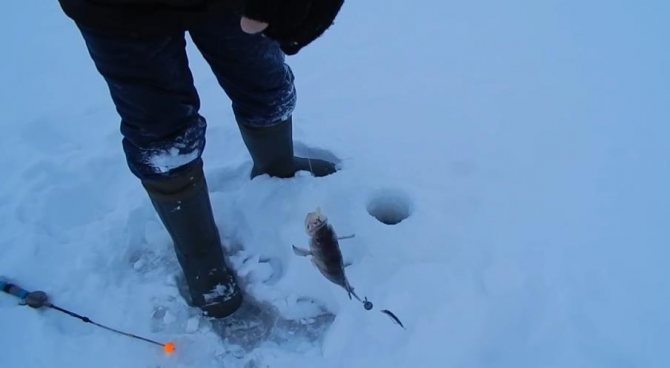
Depending on the equipment, the tactics for fishing with sprat in winter differs:
1) A rig with a simple hook is effective when fishing in the current and belongs to the passive method. A sinker is tied to the end of the main line, which will hold the tackle in place. Above, at a distance of 10-15 cm, a leash with a hook is attached.
The tackle is lowered into the hole until the weight touches the bottom, and the excess fishing line is reeled in so that the nod bends slightly and can indicate a bite. The point is that the main line stands in place vertically, and the hook with bait sways with the current, attracting the attention of a striped predator. The fisherman can only wait for the bite.
2) You can fish with artificial baits baited with sprat in the same way as with an empty hook:
– the bait sinks to the bottom;
– swing 30-40 cm and return the rod to its previous position so that the bait floats freely;
– pause and repeat the cycle.
This is the simplest version of the game. Here it is important to control the duration of the pauses, since it is during them that the bait is usually attacked by a predator. The duration directly depends on the activity of the fish - the weaker it is, the larger it is.
The height and frequency of the strokes are also selected by the angler during the fishing process. This can be influenced by weather conditions, the characteristics of the reservoir, and other factors.
What kind of bait will be used - a spinner, a balancer or a jig - also depends on the angler and the behavioral characteristics of the pike perch. It is better to have several baits with you, choosing the most catchy one directly on the pond.
Selecting a location
It’s not easy to navigate a body of water and accurately determine where a striped predator is staying. Pike perch quite often makes extensive migrations, forcing the fisherman to drill a huge number of holes and travel 10 or more kilometers in one fishing day.
When setting out to catch pike perch, you should carefully study the behavior of the predator in winter in order to determine the catching area as accurately as possible:
1. With the onset of winter, the first few weeks after the formation of ice, the activity of pike perch remains high and quite often it can be found in autumn moorings and in shallow waters.
2. In the middle of winter, during the dry winter period, the fish move to depths, where they spend most of their time, leaving the pits only for the feeding period.
3. The end of winter is associated with the beginning of the pre-spawning feast, when pike perch begins to actively feed. It follows schools of fry and small fish, moving to the confluence of meltwater and streams, where a lot of food for small fish accumulates.
On a body of water you should pay attention to the following places:
• non-silted areas with a clean rocky bottom; • deep holes, preferably filled with driftwood; • edges, on the tops of which pike perch come out to feed; • small hills where the predator can be found at the beginning and end of the winter season; • blockages of pitfalls; • places with little current, as well as the boundaries of current and standing water.
Fishing with silicone baits
If the sprat for replanting is left at home (this is a “bershatnik’s” worst dream), or has run out, and none of the fishermen nearby can share it, do not despair! Or if catching bersh with sprat in winter does not bring success, but reveals its presence with timid bites, there is another method to provoke passive fish. Perhaps the results will be even better than their neighbors when catching bersh with silicone bait or a jig.
Instead of sprat, you can successfully use a silicone nymph in winter from the American company Berkley, which positions the lures as leading ones for trout fishing, and whose developers have probably never heard of such a fish as bersh.
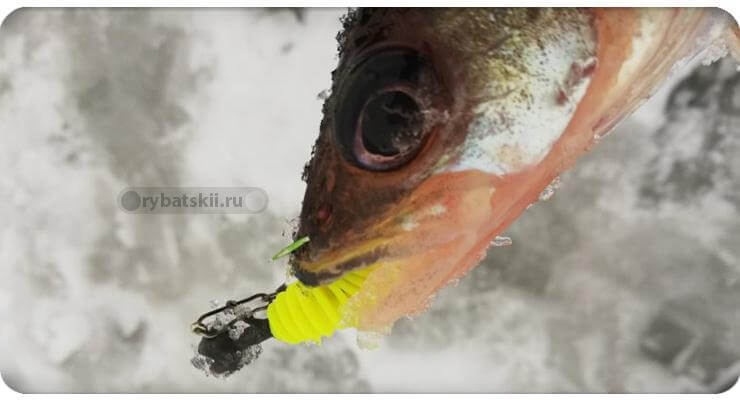
Recently, I successfully used a relatively new bait made of edible silicone from the Native Trout company while fishing, which allowed me to catch a dozen bersha during the low-biting period, which incredibly surprised the anglers nearby. These baits are attached to the hook of a large jig weighing 5–20 grams, just like sprat. The animation of such a bait is a little more active than when fishing with sprat; you should raise the bait a little higher, almost without pauses.
Catching bersh with artificial bait in winter is an interesting and promising topic; perhaps you will be able to discover a new type of bait based on this article and surprise your neighbors who use traditional sprat with your rich catch.
Ice fishing
Sprat fishing technique
When actively fishing with a bale, the angler regularly hits the bottom with the weight, which contributes to the creation of acoustic vibrations and the formation of a cloud of turbidity that attracts a predator.
When fishing with bottom tackle, the angler must smoothly lift the fishing rod from time to time so that the sinker comes off the bottom and the sprat moves to a higher layer. When fishing in a strong current, you can give the sinker the opportunity to roll along the bottom some distance from the hole, and then slowly pull it back.
Artificial bait fishing techniques
On the jig
Although the bersh is a representative of the group of perciformes, it does not like frequent and harsh play with a jig . Basic fishing when fishing with a jig with a nozzle is as follows:
- The jig is lowered to the bottom and hit the bottom with it several times.
- Raise it a few centimeters and pause.
- Then they lift the jig half a meter up with smooth movements.
- Make a stop at the top point of the wiring.
- With smooth movements, lower the jig down.
- Repeat the cycle several times.
When fishing with a baitless jig, the game should be more high-frequency.
For the spinner
Fishing with balance beams and spoons also eliminates sudden movements. Pauses during play should be long. The bait is first tapped on the bottom, then a smooth swing is made to a height of about half a meter and, after a short pause, it is released, followed by a long stop.
Expert opinion
Knipovich Nikolai Mikhailovich
Zoologist, hydrobiologist. I am interested in fishing at a professional level.
Healthy! When trolling in the current, the following technique is effective. Gradually releasing the line, let the spoon float some distance downstream. Then they begin to pull it up, slowly dragging it along the bottom.
For silicone baits
When fishing with a jig head with bait, first make several strikes on the bottom, and then throw it several times with small movements at a short distance from the bottom. Then they make a smooth swing and a smooth release, followed by a pause.
When fishing with a drop shot, the sinker is not torn off the bottom. Movements are carried out by loosening and tensioning the fishing line. Releasing the sinker downstream and then slowly pulling it up is also an effective technique when fishing for bersh.
Features of winter fishing
The main feature of the tactics for catching bersh is the constant search for schools of predators. During the day, an angler has to drill dozens of holes before he stumbles upon a school of actively feeding predators. After this, you need not to yawn: the flock moves quickly, it is not always possible to guess the vector of its movement, so it is necessary to “skim off the cream,” i.e. catch as much as possible from a catchy hole. After this, you should determine the direction of the flock, and if this cannot be done, look for a new flock.
Expert opinion
Knipovich Nikolai Mikhailovich
Zoologist, hydrobiologist. I am interested in fishing at a professional level.
Attention! A winter echo sounder can do a good job. It will not only show a school of bersh on the screen, but will also help you select the right bait and its animation, based on how the predator reacts to this bait.
Bersh responds well to bait consisting of soil mixed with chopped fish, chopped worms and bloodworms. Feeding should be done in the evening.
When fishing for bersh, pike perch are often caught, which further increases the excitement of such fishing.
